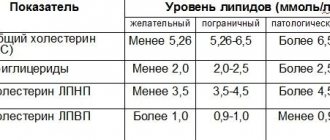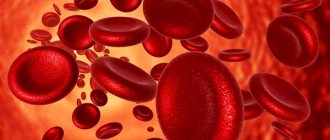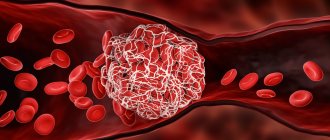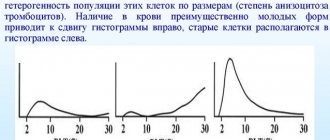Complexes with this research
Female hormones.
Menopause Assessment of the hormonal status of a woman in menopause RUB 2,220 Composition Nutritionist recommends Metabolic status assessment RUB 7,570 Composition
Thyroid gland Extended study of hormonal levels of the thyroid gland RUR 4,080 Composition
IN OTHER COMPLEXES
- Thyroid screening RUB 2,950
- Female hormones. Follicular phase 5,930 R
- Advanced women's anti-aging diagnostics RUB 28,680
- Metabolic profile RUB 5,900
- Male anti-aging diagnostics RUB 13,300
T4 indicators in the female body
The T4 hormone plays a very important role specifically for the female body, as it significantly affects reproductive function. When the hormonal background of thyroid hormones is normalized in a woman’s body, eggs are formed correctly and ovulation occurs.
The T4 hormone also controls the following processes in a woman’s body:
- body weight regulation;
- removal of harmful cholesterol;
- speed of metabolic processes;
- prevents thrombus formation.
During pregnancy, the presence of this hormone plays an important role in the formation of the internal organs and systems of the embryo, and also contributes to the proper development of the fetus. In the first trimester, with the help of thyroxine, the embryo's nervous system is formed. And its quantitative indicators influence the further normalization of its development.
That is why in pregnant women the production of T4 increases significantly, and its deficiency in the blood is associated with the transfer of some enzymes into the child’s body. Lack of T4 in pregnant women leads to various pathological changes in the embryo, and in some cases to spontaneous abortion or miscarriage.
As menopause approaches, the concentrations of this hormone in the female body decrease. In addition, there are changes in the amount of T4 depending on the seasons or time of day. In the morning its level is highest, in the afternoon it decreases significantly, and at night the concentration of thyroxine in the blood is minimal. In the autumn-winter period, there is also a clearly expressed increase in the level of this hormone, and in the summer its concentration decreases.
Detailed description of the study
Thyroxine (T4) is one of the two most important hormones produced by the thyroid gland. Together with the hormone triiodothyronine (T3), it helps regulate the rate at which the body's cells use energy.
Almost all thyroxine found in the blood forms a bond with protein. A small amount of it is found in plasma in unbound or free form. In this state, the hormone is biologically active.
The level of T4 is determined by a complex system of interaction between the hormones of the thyroid gland and pituitary gland. To maintain the optimal amount of thyroid hormones in the blood, there is an inverse relationship between them.
The pituitary gland's response to a decrease in T3 and T4 in the blood is manifested by the release of thyroid-stimulating hormone (TSH) in response to its stimulation by the hypothalamic thyrotropin-releasing hormone (TRH). TSH stimulates the functioning of thyroid cells, which increases the production of thyroid hormones. If the content of thyroid hormones in the blood is higher than normal, the secretion of TSH decreases, therefore the thyroid gland produces less T4.
In the case of normal functioning of all three organs (hypothalamus, pituitary gland and thyroid gland), T4 production is stable.
If the thyroid gland does not secrete enough T4 hormone due to dysfunction or insufficient production of TSH, then a person may experience the following manifestations of hypothyroidism:
- Increase in body weight;
- Dry skin;
- Increased sensitivity to cold;
- Menstrual irregularities;
- Increased fatigue.
Hashimoto's thyroiditis is one of the most common causes of hypothyroidism.
Otherwise, the thyroid gland produces too much T4, which causes symptoms reflecting an overactive thyroid gland. This condition is called "hyperthyroidism". It may have the following manifestations:
- Increased heart rate;
- Anxiety;
- Loss of body weight for no apparent reason;
- Difficulty sleeping;
- Sweating.
Graves' disease is one of the most common causes of hyperthyroidism.
Both hyper- and hypothyroidism can also be caused by inflammation of the thyroid gland or the presence of a malignant neoplasm in it, as well as pathology of the pituitary gland. The effect of these conditions on thyroid hormone production can be detected and monitored by measuring free T4.
Reference values and norms T4
Independent interpretation of the analysis results will not give the desired result. It should be carried out by the attending physician, who is based not only on the hormone levels, but also on other individual indicators of the patient.
The levels of the T4 hormone in different laboratories may differ significantly, since different equipment and certain reagents are used to conduct the study.
For an adult, the norm of free thyroxine in the blood is usually from 10.8 to 22.0 pmol/liter, for a child 12.5–21.5 pmol/liter. The indicators of a pregnant woman vary from 7.6 to 18.6 pmol/liter. The normal level of total thyroxine for a man is 59-139 nmol/liter, for a woman – 71-142 nmol/liter, for children over five years old – 83-172 nmol/liter. In pregnant women, this figure is 75-230 nmol/liter.
Increasing T4 levels in the body
An increase in this hormone in the body, not during pregnancy, can be caused by the following reasons:
- obesity;
- glomerulonephritis;
- taking artificial thyroxine preparations;
- presence of HIV;
- multiple myeloma;
- thyroiditis in the acute phase;
- postpartum disorders of the thyroid gland.
At high concentrations of the thyroid hormone T4 in the human body, some characteristic symptoms are observed. Among them are heart rhythm disturbances, tachycardia, increased temper and irritability, increased sweating, tremors of the upper and lower extremities. weight loss, increased fatigue, loss of strength. An overestimation of T4 levels often accelerates the breakdown of fat and leads to an excess of energy, which negatively affects various internal organs, complicating their work and accelerating their wear and tear.
This condition also has a negative effect on the nervous system, which entails frequent mood swings, negative emotional coloring, and trembling throughout the body.
When the level of thyroxine in the human body increases for a fairly long period of time, calcium is washed out from bone tissue, which leads to osteoporosis and frequent fractures.
T4 hormone during pregnancy
Thyroxine levels play a very important role in fetal development. The free hormone T4 in the first 3 months of pregnancy ensures the development and growth of the embryo's nervous system, so its deficiency can lead to various congenital pathologies. The thyroxine content in women and men is approximately the same, but during pregnancy it is not recommended to determine the level of total T4. In a pregnant woman, there is a physiological increase in the synthesis of thyroxine-binding globulin, and it binds most of the T4 in the bloodstream. Determination of total T4 during this period is not very informative, since its value will invariably be elevated, despite the fact that the free fraction of the hormone is normal.
During pregnancy, it is necessary to test free T4 hormone
, this indicator will help to objectively assess the functioning of the gland. It happens that healthy pregnant women experience a slight increase in free thyroxine that does not require treatment. But if this indicator significantly exceeds the upper limit, it is necessary to reduce the indicator through drug therapy. Treatment is carried out very carefully, under constant monitoring of thyroxine, to ensure normal development of the fetus.
Author of the article:
Kuzmina Vera Valerievna |
Endocrinologist, nutritionist Education: Diploma of the Russian State Medical University named after. N.I. Pirogov, specialty “General Medicine” (2004). Residency at the Moscow State Medical and Dental University, diploma in Endocrinology (2006). Our authors
Reasons for decreased T4 production in women
Reasons why thyroxine secretion in women is lower than normal:
- Inflammation of the structures of the hypothalamus and pituitary gland.
- Sheehan's syndrome.
- Tumors of the thyroid gland.
- Head injuries.
- Taking drugs.
- Insufficient intake of iodine into the body.
- Uncontrolled use of anticonvulsants.
- Excessive physical activity.
- Surgical interventions on internal organs.

Reduced thyroxine occurs in women whose work involves heavy metals.
How to get tested?
To determine the level of T4 in the body, it is necessary to donate blood from a vein in a laboratory setting.
To do this, you must follow a number of rules:
- Blood must be donated on an empty stomach, the last meal must be taken 10 hours before donation.
- It is necessary for the body to be at rest during the process of donating blood. You also need to avoid physical activity at least one day before the test.
- It is necessary to stop taking any medications 2 days before the test.
- Drinking alcohol and smoking should also be avoided several days before the test.
Treatment of abnormalities
Most often, deviations from the norm in free T4 levels occur due to poor nutrition or taking any medications.
If the amount of T4 is below normal for other reasons, then the patient is prescribed long-term complex therapy for hormone replacement. If its level exceeds the norm, then treatment is carried out with drugs that suppress the function of the thyroid gland.
Reference! The most commonly prescribed drug for this pathology is levothyroxine, which is a synthetic form of free T4.
The thyroid gland is a producer of endocrine hormones, one of which is the important hormone T4.

In addition to promoting the body’s most important metabolic processes, it also promotes the absorption of all proteins, carbohydrates and fats consumed by a person.
Violation of the free T4 content in the body can lead to malfunctions of the endocrine system and other pathologies of internal organs.
T4 hormone is low
Low T4 hormone is usually characteristic of insufficient hormonal function of the thyroid gland. This pathology is called hypothyroidism.
The causes of low T4 hormone levels include the following conditions:
- Treatment of thyrotoxicosis with thyreostatics or radioactive iodine;
- Autoimmune thyroiditis (the body produces antibodies against the cells of the thyroid follicles, which leads to insufficient production of thyroxine);
- Removal of the gland or part of it through surgery.
There are cases when apparently healthy people have low free T4 hormone.
Most often this is due to errors when performing research in the laboratory.
When rechecked in better laboratory centers, it turns out that the thyroxine concentration is normal. To avoid errors in diagnosis, it is necessary to take into account the clinical picture and the value of the TSH level. In all cases when the T4 hormone is low in the analysis, and the TSH hormone is within the normal range,
the result should be interpreted with caution and, if possible, a repeat test should be performed.
If a recheck in a good laboratory again shows a reduced level of thyroxine, you need to contact an endocrinologist. Insufficiency of thyroid function is usually lifelong. Therefore, continuous therapy with the administration of the synthetic hormone T4 is necessary. Artificially obtained thyroxine is identical in structure to the natural hormone and does not cause any side effects if the dosage is correctly selected.
Reasons for decreased T4 hormone (total and free):
- Sheehan syndrome;
- Congenital and acquired endemic goiter;
- Autoimmune thyroiditis;
- Traumatic brain injuries;
- Inflammatory processes in the pituitary gland and hypothalamus;
- Hypothyroidism
- Treatment with tamoxifen, antithyroid drugs (mercazolyl, propylthiouracil), steroids and anabolics, beta-blockers (metoprolol, propranolol), NSAIDs (diclofenac, ibuprofen), statins (atorvastatin, simvastatin), antituberculosis and anticonvulsants, diuretics, lithium salts, taking X-ray contrast substances.








